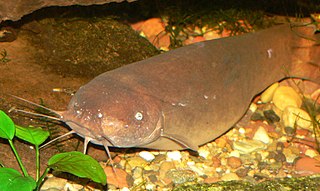
Electrophorus electricus is the best-known species of electric eel. It is a South American electric fish. Until the discovery of two additional species in 2019, the genus was classified as the monotypic, with this species the only one in the genus. Despite the name, it is not an eel, but rather a knifefish. It is considered as a freshwater teleost which contains an electrogenic tissue that produces electric discharges.

The electric rays are a group of rays, flattened cartilaginous fish with enlarged pectoral fins, composing the order Torpediniformes. They are known for being capable of producing an electric discharge, ranging from 8 to 220 volts, depending on species, used to stun prey and for defense. There are 69 species in four families.

An electric fish is any fish that can generate electric fields. Most electric fish are also electroreceptive, meaning that they can sense electric fields. The only exception is the stargazer family (Uranoscopidae). Electric fish, although a small minority of all fishes, include both oceanic and freshwater species, and both cartilaginous and bony fishes.

Electroreception and electrogenesis are the closely related biological abilities to perceive electrical stimuli and to generate electric fields. Both are used to locate prey; stronger electric discharges are used in a few groups of fishes to stun prey. The capabilities are found almost exclusively in aquatic or amphibious animals, since water is a much better conductor of electricity than air. In passive electrolocation, objects such as prey are detected by sensing the electric fields they create. In active electrolocation, fish generate a weak electric field and sense the different distortions of that field created by objects that conduct or resist electricity. Active electrolocation is practised by two groups of weakly electric fish, the Gymnotiformes (knifefishes) and the Mormyridae (elephantfishes), and by Gymnarchus niloticus, the African knifefish. An electric fish generates an electric field using an electric organ, modified from muscles in its tail. The field is called weak if it is only enough to detect prey, and strong if it is powerful enough to stun or kill. The field may be in brief pulses, as in the elephantfishes, or a continuous wave, as in the knifefishes. Some strongly electric fish, such as the electric eel, locate prey by generating a weak electric field, and then discharge their electric organs strongly to stun the prey; other strongly electric fish, such as the electric ray, electrolocate passively. The stargazers are unique in being strongly electric but not using electrolocation.

Malapterurus electricus is a thickset fish with six mouth barbels and a single fin on its back, just anterior to the rounded tail fin. It is brownish or grayish, irregularly spotted with black, and attains a length and weight of about 1.2 metres and 23 kilograms (51 lb) M. electricus is capable of generating and controlling the discharge of up to 450 volts of electricity. It uses its power to defend itself and to capture prey.

In biology, the electric organ is an organ that an electric fish uses to create an electric field. Electric organs are derived from modified muscle or in some cases nerve tissue, called electrocytes, and have evolved at least six times among the elasmobranchs and teleosts. These fish use their electric discharges for navigation, communication, mating, defence, and in strongly electric fish also for the incapacitation of prey.

Malapterurus is a genus of catfishes of the electric catfish family (Malapteruridae). It includes 18 species.
Malapterurus barbatus is a species of electric catfish native to Guinea, Sierra Leone and Liberia. This species grows to a length of 21.5 centimetres (8.5 in) SL.
Malapterurus melanochir is a species of electric catfish endemic to the Democratic Republic of the Congo, where it occurs in the upper and middle Congo River basin. This species grows to a length of 98 centimetres (39 in) SL.
Malapterurus occidentalis is a species of electric catfish native to Gambia and Guinea-Bissau, where it occurs in the Gambia and Géba Rivers. This species grows to a length of 32 centimetres (13 in) SL.
Malapterurus punctatus is a species of electric catfish native to Côte d'Ivoire, Guinea, Liberia and Sierra Leone. This species grows to a length of 21.49 centimetres (8.46 in) SL.
Malapterurus stiassnyae is a species of electric catfish native to Guinea, Liberia and Sierra Leone. Members of this species grow to a length of 30 centimetres (12 in) SL.
Malapterurus tanganyikaensis is a species of electric catfish native to Lake Tanganyika where it occurs in the bordering nations of Burundi, the Democratic Republic of the Congo, Tanzania and Zambia. This species grows to a length of 49.5 centimetres (19.5 in) SL.
Malapterurus tanoensis is a species of electric catfish native to Côte d'Ivoire and Ghana where it occurs in the Ofin and Tano Rivers.
Malapterurus teugelsi is a species of electric catfish endemic to Guinea where it occurs in the Kogon River. This species grows to a length of 21.2 centimetres (8.3 in) SL.
Paradoxoglanis caudivittatus is a species of electric catfish endemic to the Democratic Republic of the Congo where it is found in the Tshuapa and Lukenie River systems. This species grows to a length of 12.5 centimetres (4.9 in) SL.
Paradoxoglanis cryptus is a species of electric catfish endemic to the Democratic Republic of the Congo, where it occurs in the Kagala River. This species grows to a length of 11.9 centimetres (4.7 in) SL.
Paradoxoglanis parvus is a species of electric catfish endemic to the Democratic Republic of the Congo, where it is found in the Congo and Kumbinanimi River systems. This species grows to a length of 16.9 centimetres (6.7 in) SL.

The electric eels are a genus, Electrophorus, of neotropical freshwater fish from South America in the family Gymnotidae. They are known for their ability to stun their prey by generating electricity, delivering shocks at up to 860 volts. Their electrical capabilities were first studied in 1775, contributing to the invention in 1800 of the electric battery.
The history of bioelectricity dates back to ancient Egypt, where the shocks delivered by the electric catfish were used medicinally.








